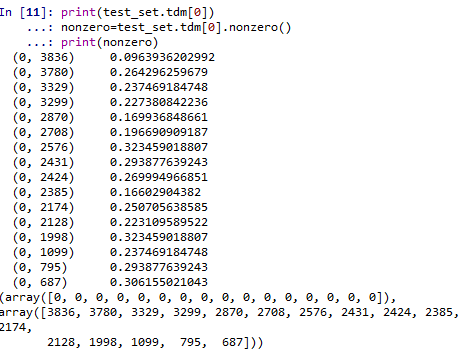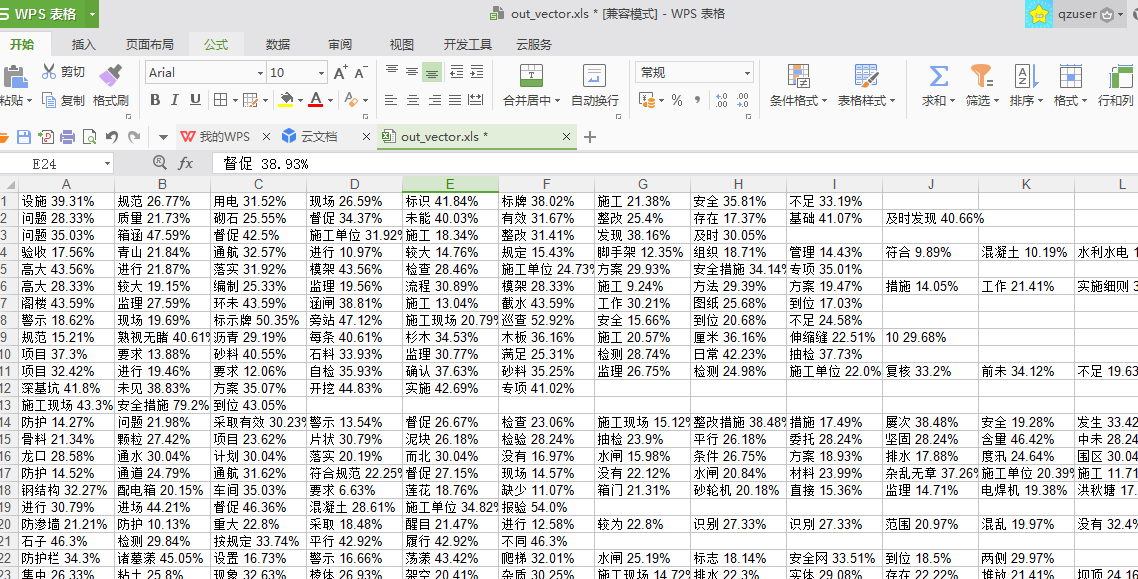python文字挖掘輸出權重,詞頻等資訊,畫出3d權重圖
阿新 • • 發佈:2018-12-10
# -*- coding: utf-8 -*- from pandas import read_csv import numpy as np from sklearn.datasets.base import Bunch import pickle # 匯入cPickle包並且取一個別名pickle #持久化類 from sklearn.feature_extraction.text import TfidfVectorizer import jieba import operator # 排序用 from sklearn import metrics from sklearn.externals import joblib import xlwt def importSmallContentdata(file, data, art, label, f, Slast, Snew): dataset = read_csv(file) Sdata = dataset.values[:, :] print(type(Sdata)) if f == 1: for line in Sdata: ls = [] ls.append(line[14]) ls.append(line[15]) ls.append(line[16]) ls.append(line[17]) Slast.append(ls) # print(len(Slast)) # print("需要對照的小類資料準備完畢") '''找到smalli不為0的裝入Straindata,把資料分開''' for smalli in range(14, 18): # print(smalli) count = 0 for line in Sdata: count = count + 1 if line[smalli] != '0' and line[smalli] != 0: k = 1 ls = [] for i in line: if k == 1: #art.append(i) k = k + 1 continue if k == 11: # k為14並不代表是line[14],因為line是從0開始 break ls.append(float(i)) k = k + 1 data.append(ls) label.append(line[smalli]) if f == 1: Snew.append(count) for line in Sdata: art.append(line[0]) # print("為什麼都超限",len(Snew)) def getKvector(train_set, vec, n): class obj: def __init__(self): self.key = 0 self.weight = 0.0 nonzero = train_set.tdm.nonzero() k = 0 lis = [] gather = [] p = -1 for i in nonzero[0]: p = p + 1 if k == i: a = obj() a.key = nonzero[1][p] a.weight = train_set.tdm[i, nonzero[1][p]] lis.append(a) else: lis.sort(key=lambda obj: obj.weight, reverse=True) # 對連結串列內為類物件的排序 gather.append(lis) while k < i: k = k + 1 lis = [] a = obj() a.key = nonzero[1][p] a.weight = train_set.tdm[i, nonzero[1][p]] lis.append(a) gather.append(lis) # gather儲存的是每條資料的事實描述的特徵向量,已經從小到大排好了,只不過每個存既有key又有weight # 我們只要key,不再需要weight sj = 1 for i in gather: ls = [] for j in i: sj = sj + 1 ls.append(float(j.key)) while sj <= n: sj = sj + 1 ls.append(-1) sj = 1 vec.append(ls) '''讀取停用詞''' def _readfile(path): with open(path, "rb") as fp: content = fp.read() return content ''' 讀取bunch物件''' def _readbunchobj(path): with open(path, "rb") as file_obj: bunch = pickle.load(file_obj) return bunch '''寫入bunch物件''' def _writebunchobj(path, bunchobj): with open(path, "wb") as file_obj: pickle.dump(bunchobj, file_obj) def buildtrainbunch(bunch_path, art_train, trainlabel): bunch = Bunch(label=[], contents=[]) for item1 in trainlabel: bunch.label.append(item1) # trainContentdatasave=[] #儲存所有訓練和測試資料的分詞 for item2 in art_train: item2 = str(item2) item2 = item2.replace("\r\n", "") item2 = item2.replace(" ", "") content_seg = jieba.cut(item2) save2 = '' for item3 in content_seg: if len(item3) > 1 and item3 != '\r\n': # trainContentdatasave.append(item3) save2 = save2 + "," + item3 bunch.contents.append(save2) with open(bunch_path, "wb") as file_obj: pickle.dump(bunch, file_obj) print("構建訓練資料文字物件結束!!!") def buildtestbunch(bunch_path, art_test, testlabel): bunch = Bunch(label=[], contents=[]) for item1 in testlabel: bunch.label.append(item1) # testContentdatasave=[] #儲存所有訓練和測試資料的分詞 for item2 in art_test: item2 = str(item2) item2 = item2.replace("\r\n", "") item2 = item2.replace(" ", "") content_seg = jieba.cut(item2) save2 = '' for item3 in content_seg: if len(item3) > 1 and item3 != '\r\n': # testContentdatasave.append(item3) save2 = save2 + "," + item3 bunch.contents.append(save2) with open(bunch_path, "wb") as file_obj: pickle.dump(bunch, file_obj) print("構建測試資料文字物件結束!!!") def vector_space(stopword_path, bunch_path, space_path): stpwrdlst = _readfile(stopword_path).splitlines() # 讀取停用詞 bunch = _readbunchobj(bunch_path) # 匯入分詞後的詞向量bunch物件 # 構建tf-idf詞向量空間物件 tfidfspace = Bunch(label=bunch.label, tdm=[], vocabulary={}) # 權重矩陣tdm,其中,權重矩陣是一個二維矩陣,tdm[i][j]表示,第j個詞(即詞典中的序號)在第i個類別中的IF-IDF值 # 使用TfidVectorizer初始化向量空間模型 vectorizer = TfidfVectorizer(stop_words=stpwrdlst, sublinear_tf=True, max_df=0.5, min_df=0.0001, use_idf=True, max_features=15000) # print(vectorizer) # 文字轉為詞頻矩陣,單獨儲存字典檔案 tfidfspace.tdm = vectorizer.fit_transform(bunch.contents) tfidfspace.vocabulary = vectorizer.vocabulary_ # 建立詞袋的持久化 _writebunchobj(space_path, tfidfspace) print("if-idf詞向量空間例項建立成功!!!") def testvector_space(stopword_path, bunch_path, space_path, train_tfidf_path): stpwrdlst = _readfile(stopword_path).splitlines() # 把停用詞變成列表 bunch = _readbunchobj(bunch_path) tfidfspace = Bunch(label=bunch.label, tdm=[], vocabulary={}) # 匯入訓練集的TF-IDF詞向量空間 ★★ trainbunch = _readbunchobj(train_tfidf_path) tfidfspace.vocabulary = trainbunch.vocabulary vectorizer = TfidfVectorizer(stop_words=stpwrdlst, sublinear_tf=True, max_df=0.7, vocabulary=trainbunch.vocabulary, min_df=0.001) tfidfspace.tdm = vectorizer.fit_transform(bunch.contents) _writebunchobj(space_path, tfidfspace) print("if-idf詞向量空間例項建立成功!!!")
if __name__=="__main__": Stestdata = [] Stestlabel = [] Sart_test = [] Slast = [] Snew = [] '''============================先匯入資料==================================''' file_test = 'F:/goverment/excel operating/all_tocai_train.csv' importSmallContentdata(file_test, Stestdata, Sart_test, Stestlabel, 1, Slast, Snew) #print(Sart_test) # print("Stestlabel" ,len(Stestlabel)) # print("小類匯入資料完畢") # print("大類標籤匯入完畢")#共1329*4 '''==========================================================tf-idf對Bar進行文字特徵提取============================================================================''' # 匯入分詞後的詞向量bunch物件 test_bunch_path = "F:/goverment/excel operating/trainbunch.bat" test_space_path = "F:/goverment/excel operating/traintfdifspace.dat" stopword_path = "F:/goverment/excel operating/hlt_stop_words.txt" '''============================================================tf-idf對Sart進行文字特徵提取==============================================================================''' buildtestbunch(test_bunch_path, Sart_test, Stestlabel) testvector_space(stopword_path, test_bunch_path, test_space_path, test_space_path) test_set = _readbunchobj(test_space_path) '''測試資料''' #獲取已知 id 找 文字 dic={} for i in test_set.vocabulary.keys(): dic[test_set.vocabulary[i]]=i #print(dic)
test_set分為三部分

print(test_set.tdm) (0, 3836) 0.0963936202992 (0, 3780) 0.264296259679 (0, 3329) 0.237469184748 (0, 3299) 0.227380842236 (0, 2870) 0.169936848661 (0, 2708) 0.196690909187 (0, 2576) 0.323459018807 (0, 2431) 0.293877639243 (0, 2424) 0.269994966851 (0, 2385) 0.16602904382 (0, 2174) 0.250705638585 (0, 2128) 0.223109589522 (0, 1998) 0.323459018807 (0, 1099) 0.237469184748 (0, 795) 0.293877639243 (0, 687) 0.306155021043 (1, 4127) 0.158745878875 (1, 4075) 0.187148908824 (1, 4066) 0.275285441964 (1, 3506) 0.325600030259 (1, 3329) 0.271913955503 (1, 2512) 0.30263228246 (1, 2385) 0.190111462595 (1, 2121) 0.370376566292 (1, 1555) 0.325600030259 : : (1437, 790) 0.216605181177 (1437, 784) 0.30372112351 (1437, 558) 0.20127256985 (1438, 4279) 0.240643793924 (1438, 4276) 0.118606614328 (1438, 4184) 0.148565457218 (1438, 4107) 0.185731268834 (1438, 4014) 0.154101569448 (1438, 3877) 0.220155031015 (1438, 3298) 0.245309299377 (1438, 2933) 0.318303833306 (1438, 2383) 0.0923818814565 (1438, 2378) 0.213187531379 (1438, 2092) 0.263926619628 (1438, 2091) 0.263926619628 (1438, 1969) 0.15613334884 (1438, 1802) 0.144868484461 (1438, 1714) 0.256704677923 (1438, 1447) 0.309102127772 (1438, 1411) 0.226077842579 (1438, 1010) 0.116062811153 (1438, 997) 0.263926619628 (1438, 648) 0.15613334884 (1438, 640) 0.157728638816 (1438, 565) 0.232695024234

打印出分詞及權重
#各個文字的詞語及權重
dataset = read_csv(file_test)
Sdata = dataset.values[:, :]
print(len(Sdata))
#print(nonzero[1])
myexcel = xlwt.Workbook()
sheet = myexcel.add_sheet("sheet1")
for k in range(len(Sdata)):#遍歷每一條文字
nonzero=test_set.tdm[k].nonzero()
ls=[]
for i in range(len(nonzero[1])):
b=test_set.tdm[k, nonzero[1][i]]*100 #test_set.tdm[k, nonzero[1][i]]是第k條文字中,第i個權重非零的詞權重
a= dic[nonzero[1][i]] +" "+str(round(b,2))+"%"
ls.append(a)
for i in range(len(nonzero[1])):
sheet.write(k,i,str(ls[i]))
myexcel.save("out_vector.xls")執行結果如下:

畫出3d圖:還可以轉動呢

